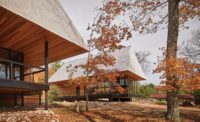Never the same shot
Golf is also like architecture in that there are no cookie-cutter plans, or at least no good ones. Unlike bowling or tennis, golf is played on a surface in which every course, every fairway, every green is different. In a lifetime, you never play exactly the same shot twice. Isn’t that part of what makes the practice of architecture, too, so fascinating?
Mark Twain should have tried golf. He might have come up with something to rival John Updike’s marvelous short story “Farrell’s Caddie,” in which a wizened caddie steers a callow American golfer around a Scots course. Updike describes the caddies as “hunched little men in billed tweed caps and rubberized rain suits, huddled in the misty gloom,” which may not sound much like your desk critics in design school, but Sandy the caddie coaches his American visitor with a similar mix of encouragement, challenge, and collaboration. Eventually, writes Updike, “Farrell and his caddie began to grow into one another, as a foot in damp weather grows into a shoe.”
I’m no landscape historian, so I consulted some experts as to whether my instinct is right about the similarity between the American golf course and the English country garden of Capability Brown. Betsy Rogers is the founder of the Central Park Conservancy, and her book, Landscape Design: A Cultural and Architectural History, is the only one I know of that deals with golf. On the phone, she gives me a “Yes, but.” Says Betsy: “They’re both designed landscapes, they’re both recreational, and they both go back to the 18th century in the British isles.” She sees the resemblance, but she says golf courses were and are usually designed by golf pros and specialists, and she can’t document any direct influence.
I try Doug Reed of the Boston landscape firm Reed, Hilderbrand, who says, “It sounds so right and believable to me, but I don’t know of any literature on it.”
I phone Peter Schaudt of Hoerr Schaudt landscape architects in Chicago, and here I finally hit a kind of jackpot. Schaudt first says, “I would guess there’s a genuine correlation,” and he then speculates that early golf courses were sometimes converted from private estates, the former garden being directly transformed into the future golf course. Then he begins talking about the late Dan Kiley, the great landscape architect, for whom Schaudt once worked.
Kiley, says Schaudt, was a golf nut who hated Capability Brown and forbade the name from being mentioned in the office. “He thought Brown’s work was a profanity,” says Schaudt. “He thought he ruined many good landscapes.” What were the landscapes he ruined? They were the axial, gridded, geometric parks we associate with continental Europe, the opposite of Brown’s more free-form, more romantic, let’s-pretend-it’s-natural spaces.
“Dan always wanted to design a Le Notre golf course,” says Schaudt, referring to the French designer of the formal gardens at Vaux-le-Vicomte and Versailles. “It would have had a symmetrical, axial plan. When Dan played, he always hit straight short axial shots, and he always beat us younger guys who were hitting longer balls but spraying them all over the course.”
I rest my case. If Dan Kiley despised Capability Brown, and if he wanted golf courses to look more like Le Notre, then he’s at least implying that actual courses are too Brownian.
Dan Kiley was very much a Modernist, of course, not a product of the French Baroque. But like so many classical Modernists, he was in love with grids and geometric rigor. You have to wonder whether anyone has ever attempted a Modernist golf course. What would one look like? Or is the American golf course so deeply imbedded in the mythos of the Romantic movement that any change would be impossible?


Post a comment to this article
Report Abusive Comment